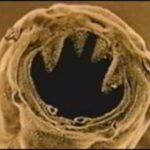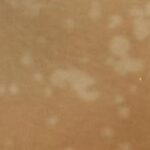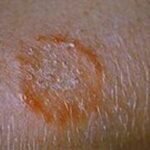Ringworm is a highly contagious fungus skin infection known in medical terms as Tinea.Tinea or Ringworm can affect any part of the body. Contrary to common belief, there is no worm that causes this disease. It is a fungus, classified under the group called Dermatophytes (parasites living on the skin). There can be many types of ringworm, based on the location where this characteristic red ringed fungus appears on the body.
Types of Tinea
As is the general practice in naming a disease, Latin is the language that is used to name this skin disease. This fungus lives on a substance called keratin, found in the dead, outer layers of the skin, hair and nails. But, mostly, it attacks the moist warm areas such as groin, armpits, beneath the breasts, hands and feet. It is called Tinea Capitis, if it attacks the scalp and head, Tinea Pedis, affects the feet, also called Athlete’s foot, Tinea Barbae, if the attack is in the bearded area of the chin of men. Tinea Barbae is most commonly called Barber’s itch. Another common form is Tinea Cruris, which is ringworm of groin, famously called jock itch. There could be many other forms of ringworm too, like that which attacks the fingernails and toenails. While most of the fungus is a parasite living off human skin, certain forms can also live on animals. The fungus can be transferred from a pet to human by direct contact.
How is ringworm spread?
Ringworm is spread by direct contact with people or animals that are infected with it. It can also be spread through contact with objects used by an infected person. Because Tinea fungi can be spread so easily, bed sheets, hair brushes, combs, telephones and other objects should be cleaned frequently. Objects should be sprayed with disinfectants.
Symptoms of ringworm
The main characteristic symptom of ringworm is the red ring, which begins as a simple blister/pimple and spreads outward; the fungal infection leaves scaly patches on the skin.
If the location the ringworm is around hair, there may be a temporary phase of baldness at the site of fungal infection.
There will be itching and there may be cracking of the skin.
How is ringworm diagnosed?
Your family doctor or a dermatologist can identify the infection by making a general inspection of the site of the infection on the skin. Usually the characteristic red ring can be seen without magnification from a magnifying glass. Your physician can confirm the disease and the organism causing it by doing a skin scraping test. The flakes of skin from the scraping will be sent to the lab where it will be observed under a microscope. A culture test may also be conducted to isolate the fungus to establish the diagnosis of ringworm.
How is ringworm treated?
Most infections of ringworm can be treated with topical lotions and creams containing microbial or fungicidal medicines. In the olden days, mercury based and iodine based creams were commonly used. But, now, there are many fungicidal creams available over-the-counter and by a doctor’s prescription. Very rarely, depending on the location of the ringworm, and the age of the patient, medicines including antifungal and antibiotic drugs are advised to be taken orally also, in addition to the topical applications.
Conclusion
Once you start treating ringworm with a cream like Lotrimin, Desenex or some other topical agent the rash will begin to subside. The skin may appear clear of infection, but it can reappear if you stop using it too soon. Use the topical cream or lotion for as long as directed on the product or prescription.
Because ringworm is so contagious, it is important that you do not share your clothes, sports gear or personal items. If you have ringworm on your feet (athlete’s foot), it is important to put your socks on after you put on your under and outer clothes. Your feet need to be covered so that the organism isn’t caught on the clothing and spread to the groin area.
Sources:
http://www.webmd.com/skin-problems-and-treatments/tc/ringworm-of-the-skin-topic-overview
http://www.medicinenet.com/ringworm/page3.htm





